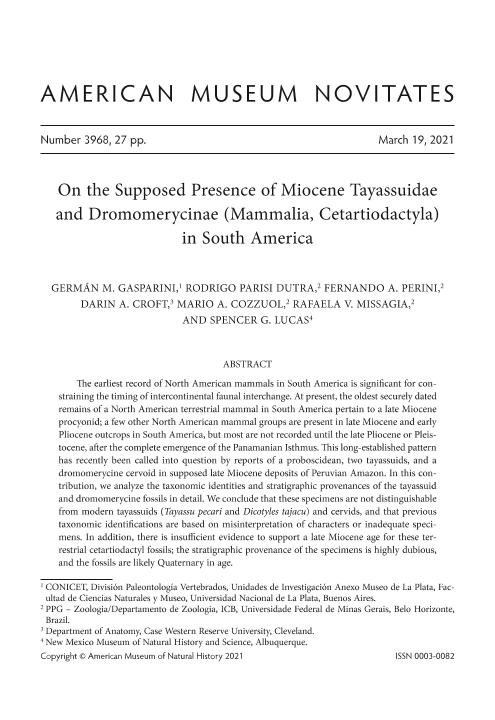Artículo
On the Supposed Presence of Miocene Tayassuidae and Dromomerycinae (Mammalia, Cetartiodactyla) in South America
Gasparini, Germán Mariano ; Parisi Dutrá, Rodrigo; Perini, Fernando A.; Croft, Darin; Cozzuol, Mario Alberto; Missagia, Rafaela V.; Lucas, Spencer G.
; Parisi Dutrá, Rodrigo; Perini, Fernando A.; Croft, Darin; Cozzuol, Mario Alberto; Missagia, Rafaela V.; Lucas, Spencer G.
 ; Parisi Dutrá, Rodrigo; Perini, Fernando A.; Croft, Darin; Cozzuol, Mario Alberto; Missagia, Rafaela V.; Lucas, Spencer G.
; Parisi Dutrá, Rodrigo; Perini, Fernando A.; Croft, Darin; Cozzuol, Mario Alberto; Missagia, Rafaela V.; Lucas, Spencer G.
Fecha de publicación:
19/03/2021
Editorial:
American Museum of Natural History
Revista:
American Museum Novitates
ISSN:
0003-0082
Idioma:
Inglés
Tipo de recurso:
Artículo publicado
Clasificación temática:
Resumen
The earliest record of North American mammals in South America is significant for constraining the timing of intercontinental faunal interchange. At present, the oldest securely dated remains of a North American terrestrial mammal in South America pertain to a late Miocene procyonid; a few other North American mammal groups are present in late Miocene and early Pliocene outcrops in South America, but most are not recorded until the late Pliocene or Pleistocene, after the complete emergence of the Panamanian Isthmus. This long-established pattern has recently been called into question by reports of a proboscidean, two tayassuids, and a dromomerycine cervoid in supposed late Miocene deposits of Peruvian Amazon. In this contribution, we analyze the taxonomic identities and stratigraphic provenances of the tayassuid and dromomerycine fossils in detail. We conclude that these specimens are not distinguishable from modern tayassuids (Tayassu pecari and Dicotyles tajacu) and cervids, and that previous taxonomic identifications are based on misinterpretation of characters or inadequate specimens. In addition, there is insufficient evidence to support a late Miocene age for these terrestrial cetartiodactyl fossils; the stratigraphic provenance of the specimens is highly dubious, and the fossils are likely Quaternary in age.
Palabras clave:
AMAZON
,
GREAT AMERICAN BIOTIC INTERCHANGE
,
MIOCENE
,
PECCARIES AND CERVIDS
Archivos asociados
Licencia
Identificadores
Colecciones
Articulos(CCT - LA PLATA)
Articulos de CTRO.CIENTIFICO TECNOL.CONICET - LA PLATA
Articulos de CTRO.CIENTIFICO TECNOL.CONICET - LA PLATA
Citación
Gasparini, Germán Mariano; Parisi Dutrá, Rodrigo; Perini, Fernando A.; Croft, Darin; Cozzuol, Mario Alberto; et al.; On the Supposed Presence of Miocene Tayassuidae and Dromomerycinae (Mammalia, Cetartiodactyla) in South America; American Museum of Natural History; American Museum Novitates; 3968; 19-3-2021; 1-27
Compartir



